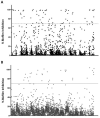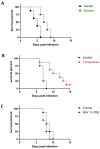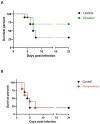High-Throughput Screening of the Repurposing Hub Library to Identify Drugs with Novel Inhibitory Activity against Candida albicans and Candida auris Biofilms
- PMID: 37754987
- PMCID: PMC10532723
- DOI: 10.3390/jof9090879
High-Throughput Screening of the Repurposing Hub Library to Identify Drugs with Novel Inhibitory Activity against Candida albicans and Candida auris Biofilms
Abstract
Candidiasis is one of the most frequent nosocomial infections affecting an increasing number of at-risk patients. Candida albicans remains the most frequent causative agent of candidiasis, but, in the last decade, C. auris has emerged as a formidable multi-drug-resistant pathogen. Both species are fully capable of forming biofilms, which contribute to resistance, increasing the urgency for new effective antifungal therapies. Repurposing existing drugs could significantly accelerate the development of novel therapies against candidiasis. Here, we have screened the Repurposing Hub library from the Broad Institute, containing over 6000 compounds, in search for inhibitors of C. albicans and C. auris biofilm formation. The primary screen identified 57 initial hits against C. albicans and 33 against C. auris. Confirmatory concentration-dependent assays were used to validate the activity of the initial hits and, at the same time, establish their anti-biofilm potency. Based on these results, ebselen, temsirolimus, and compound BAY 11-7082 emerged as the leading repositionable compounds. Subsequent experiments established their spectrum of antifungal activity against yeasts and filamentous fungi. In addition, their in vivo activity was examined in the murine models of hematogenously disseminated C. albicans and C. auris infections. Although promising, further in vitro and in vivo studies are needed to confirm their potential use for the therapy of candidiasis and possibly other fungal infections.
Keywords: Candida spp.; antifungal; biofilm; repurposing; screening.
Conflict of interest statement
The authors declare no conflict of interest. The funders had no role in the design of the study; in the collection, analyses, or interpretation of data; in the writing of the manuscript; or in the decision to publish the results.
Figures



Similar articles
-
Screening the medicine for malaria venture's Pandemic Response Box to identify novel inhibitors of Candida albicans and Candida auris biofilm formation.APMIS. 2023 Nov;131(11):613-625. doi: 10.1111/apm.13342. Epub 2023 Jun 20. APMIS. 2023. PMID: 37337909 Free PMC article.
-
Screening a Repurposing Library for Inhibitors of Multidrug-Resistant Candida auris Identifies Ebselen as a Repositionable Candidate for Antifungal Drug Development.Antimicrob Agents Chemother. 2018 Sep 24;62(10):e01084-18. doi: 10.1128/AAC.01084-18. Print 2018 Oct. Antimicrob Agents Chemother. 2018. PMID: 30104269 Free PMC article.
-
Repositionable Compounds with Antifungal Activity against Multidrug Resistant Candida auris Identified in the Medicines for Malaria Venture's Pathogen Box.J Fungi (Basel). 2019 Oct 1;5(4):92. doi: 10.3390/jof5040092. J Fungi (Basel). 2019. PMID: 31581540 Free PMC article.
-
Current scenario of the search for new antifungal agents to treat Candida auris infections: An integrative review.J Mycol Med. 2022 Mar;32(1):101232. doi: 10.1016/j.mycmed.2021.101232. Epub 2021 Dec 1. J Mycol Med. 2022. PMID: 34883404 Review.
-
Candida auris-the growing menace to global health.Mycoses. 2019 Aug;62(8):620-637. doi: 10.1111/myc.12904. Epub 2019 Jun 18. Mycoses. 2019. PMID: 30773703 Review.
Cited by
-
Image-based quantification of Candida albicans filamentation and hyphal length using the open-source visual programming language JIPipe.FEMS Yeast Res. 2025 Jan 30;25:foaf011. doi: 10.1093/femsyr/foaf011. FEMS Yeast Res. 2025. PMID: 40082735 Free PMC article.
References
Grants and funding
LinkOut - more resources
Full Text Sources
Molecular Biology Databases
Miscellaneous

